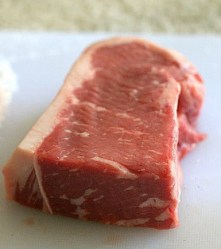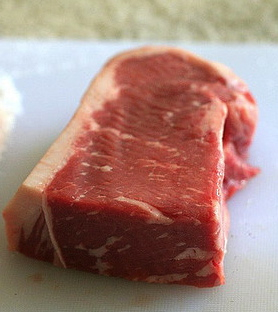
Photo by Jack Lyons.
Eric Davidson has no grand plan to turn you into a vegetarian.
But in order for us to avoid catastrophic climate change, this senior scientist and executive director at Woods Hole Research Center says people in developed nations may need to eat half as much meat. Yep — you heard that right. This isn’t about the way animals are treated, nor is it about reducing heart disease. For the sake of the climate alone, we — as a culture — need to eat half as many burgers, and half as much bacon.
According to a recent study from Davidson, this controversial dietary shift is crucial if we want to get serious about reducing emissions of nitrous oxide (N2O), a potent greenhouse gas.
We’ve long known that eating animals (who eat grains) requires a great deal more agricultural production than eating those grains ourselves. And since farming involves fertilizers and animal manure — two factors that have recently been pinpointed as major contributors of atmospheric N20 — we need to use much less of them. Oh, and while we’re at it, the way we farm also has to change, to the tune of 50 percent fewer N2O emissions.
“We have the know-how to create an intelligent food production system that meets human needs in a sustainable way — if we had the economic and political willpower to do it,” Davidson says.
With the study, Davidson wanted to determine how to meet four future scenarios for atmospheric N2O being evaluated by the Intergovernmental Panel on Climate Change (IPCC). The scenarios range from the least aggressive, business-as-usual approach, to the most aggressive reduction, which would stabilize N2O concentrations by mid-century.
And although it would be a heavy lift, that less meat/less nitrogen scenario is what’s required for the latter.
“In order to reach the most optimistic, or most aggressive, mitigation scenario … you really have to have an all-of-the-above strategy,” Davidson said.
As he explained in the study:
Technologies exist to achieve such improved efficiencies, but overcoming social, economic, and political impediments for their adoption and for changes in dietary habits will present large challenges.
All of the above
Eighty percent of N2O emissions come from agriculture, as soil organisms, such as bacteria, break down the nitrogen in livestock manure and the synthetic fertilizers applied to soil in crop production. After carbon dioxide and methane, N2O is the largest contributor to climate change, and has soared 20 percent since the Industrial Revolution. It is also our biggest human-made ozone-depleting substance.
Nitrogen, however, is vital for food production, posing an even greater challenge for reductions as the population grows. New research identifies overuse of synthetic fertilizer as a key driver behind the accelerated rise in atmospheric nitrous oxide as farmers apply the stuff too liberally on row crops as a hedge to insure yields. Even the smaller number of farmers who use nitrogen-rich manure for their crops often use too much, while far too much of the manure is produced in industrial livestock and dairy operations, and ends up in lagoons where it can leach into the water table.
“The more we eat, the more fertilizer we need, the more manure that’s produced, and more of this gas is produced,” Davidson said.
Where’s the beef?
Reversing multi-decade trends are never easy. For as long as we have kept records, meat consumption has steadily risen in both developed and developing nations, according to Roni Neff, research and policy director at the Center for a Livable Future at the Johns Hopkins Bloomberg School of Public Health.
“Today in this country, we’re eating about 41 pounds of poultry, 38 pounds of beef, and 27 pounds of pork per person per year, which means we’re slaughtering more than 9 billion animals per year,” Neff said.
Meat consumption has dipped slightly in the U.S., likely due to a combination of factors including the down economy, ethanol production’s upward pressure on meat prices, and a growing awareness of meat’s nutritional and environmental challenges, Neff said. Overall, however, long-term forecasts point upward, in part from steady global population growth.
Yet there are promising signs that some are thinking twice before ordering that burger, such as the growing Meatless Mondays movement. Neff also noted recent, much-reported on research findings showing a direct correlation between mortality rates and red meat consumption.
“The message I’d take from all this,” Neff said, “is that there are strong arguments for a significant reduction in meat consumption, from both environmental and public health standpoints.”
Four ways farmers can reduce N2O
- Optimizing nitrogen use: Farmers want to use fertilizers more efficiently because it’s an expense. Applying it at the optimal time and in the right amounts may help them get the most bang for their buck, but so much of fertilizer use is dependent on the weather.
- Technology: Tools called “variable rate applicators” can help keep farmers from using too much fertilizer, while other technologies can help them avoid overlapping their applications. A team at Washington State University is also studying how to use remote sensors to evaluate nitrogen uptake and removal in the soil.
- Changing other farm practices: Feeding livestock seed that is lower in nitrogen may reduce emissions. Planting winter cover crops can also provide root systems that use excess nitrogen.
- Financial incentives: Davidson mentions the possibility of insurance to protect against economic loss for farmers using less fertilizer. There is also a program in Maryland that will pay farmers to put in winter cover crops to reduce nutrient leaching into the Chesapeake Bay. Although the 2008 Farm Bill provided incentives for nutrient management through the Conservation Stewardship Program, it’s unclear what kind of shape this will take in the next bill.
A 50 percent reduction will be a tall order, says Dave Huggins, a soil scientist with the USDA Agricultural Research Service’s Land Management and Water Conservation Unit. Reducing overlap may save up to 15 percent in some areas, while technology and support to help farmers make decisions that drive nitrogen use efficiency could increase overall reductions to about 25 percent.
Of course, an increase in the number of organic farming systems, which by their very nature rely on a slower release of nitrogen and a much more closed nutrient loop, could also have an impact.
“Beyond that,” Huggins said, “it almost takes a change in the cropping systems themselves, in terms of what kind of crops are grown.”
Shifting from annual crops, for example, which need to be replanted every year and are inherently leaky as far as nitrogen use, to biennial or perennial grain crops, could make a huge difference. Breeding efforts are underway to perennialize wheat, for example, so it doesn’t need annual planting. (Sadly, the research is underfunded, so don’t expect to see that wheat on the market any time soon.)
“Progress is slow,” Huggins said, “and there are not enough crop breeders working in this area.”
Of course, that could change — and it wouldn’t be a moment too soon if it did. The IPCC’s most stringent scenario of stabilizing N2O emissions by 2050 may sound far into the future — but in order to make that happen, we need to get started today.



